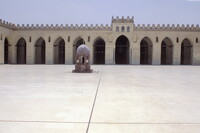Mosque of al-Hakim
unknown (Egyptian (modern))

Download1A3-I-E-MAH-B3_cp.jpg (314.8Kb)
Date
990-1013Description
General view within the sahn (court), showing the ablution fountain; The Fatimid caliph al-'Aziz (reigned 975-996) began construction in 989 or 990 of a huge mosque (120 x 113 m) just outside the north wall of al-Qahira; his son al-Hakim (reigned 996-1021) completed the building in 1013. It was erected to accommodate not only the ever-burgeoning population of Cairo but also Fatimid pageantry, for the imams visited successive mosques on religious festival days, accompanied by much cermonial pomp. The bastions erected in 1010-1011 to encase the minarets are the most enigmatic feature of the mosque. Bloom suggested that the shape of the minarets (square bases leading to polygonal or circular shafts) deliberately alluded to that of those on the Haram in Mecca, but after Fatimid-Meccan relations deteriorated, al-Hakim prohibited his subjects from visiting Mecca and ordered the minarets to be concealed. In 1980 the mosque was again restored in inappropriate gilt and gleaming marble. Source: Grove Art Online; http://www.groveart.com/ (accessed 1/18/2008)
Type of Work
mosqueSubject
architectural exteriors, rulers and leaders, Fatimid
Rights
Rights Statement
Licensed for educational and research use by the MIT community only